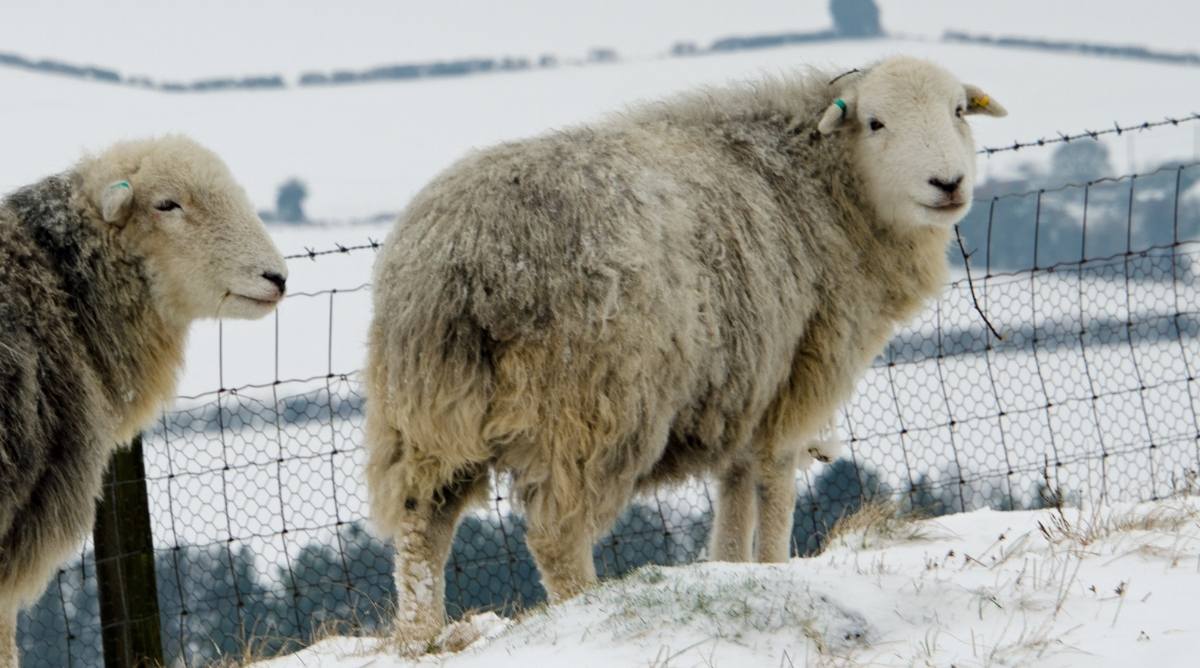Caring for your sheep in winter requires focusing on warmth, sufficient food, shelter from harsh conditions, and warm, fresh drinking water. Even though sheep are resilient against the cold, they need extra care to ensure they are safe and comfortable during frigid winters.
Table of Contents
Can sheep survive in the snow?
Sheep can survive in the snow thanks to their wool coat which insulates their bodies, keeping them warm during winter. Wild sheep are always outside, even during heavy snow and inclement weather.
Domesticated sheep are more likely to survive in the snow thanks to the care they receive from the farmers.
Not all breeds do well in the snow. Some of the breeds that do well in the winter include Leicester Longwool, Shetland, Romney, Icelandic, and Black Welsh Mountain.
Whether your sheep adapt well to cold weather or not, you need to help them survive the winter season by offering shelter, food, and warm drinking water.
How sheep naturally adapt to winter
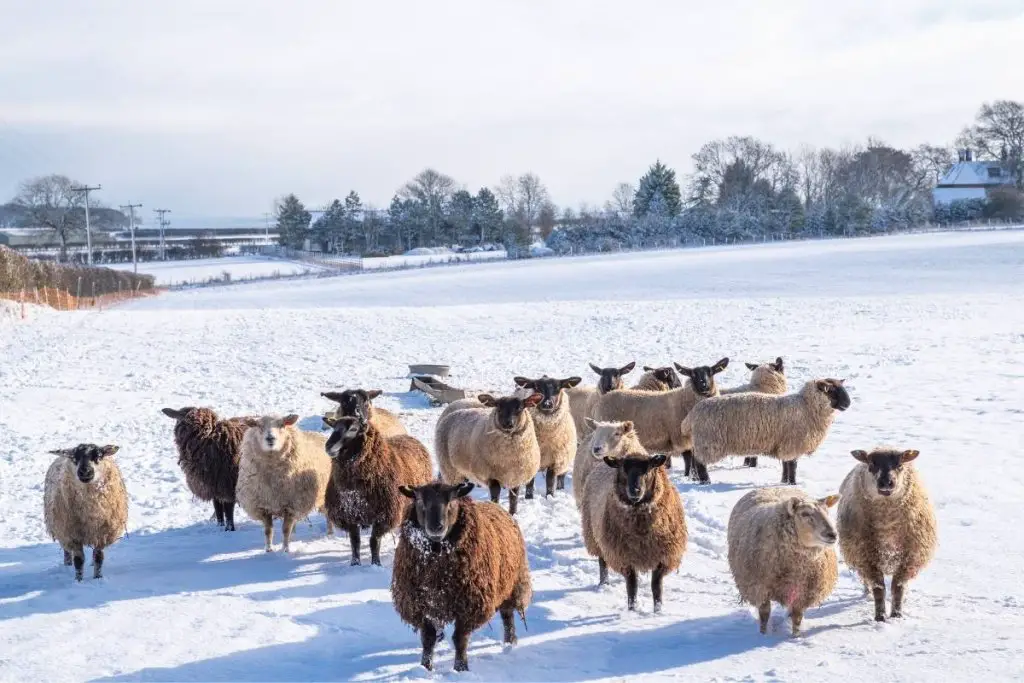
Sheep naturally adapt to winter by growing longer coats of wool. They also generate warmth in winter by huddling together to conserve heat.
It’s not unusual to see a flock of sheep huddling together in the snowy fields during winter.
Domesticated sheep are at an advantage during winter because they are bred to grow long wool. So long as the sheep haven’t been recently shorn, their wool will have grown long enough by winter to warm their bodies.
During winter, sheep also adapt by eating more, which produces heat.
Sheep naturally seek shelter from the elements when temperatures dip or when it’s too windy. For this reason, building a shelter for your sheep is advisable. You can construct a barn or a simple three-sided shed that the sheep can access easily.
How to care for your sheep in snow
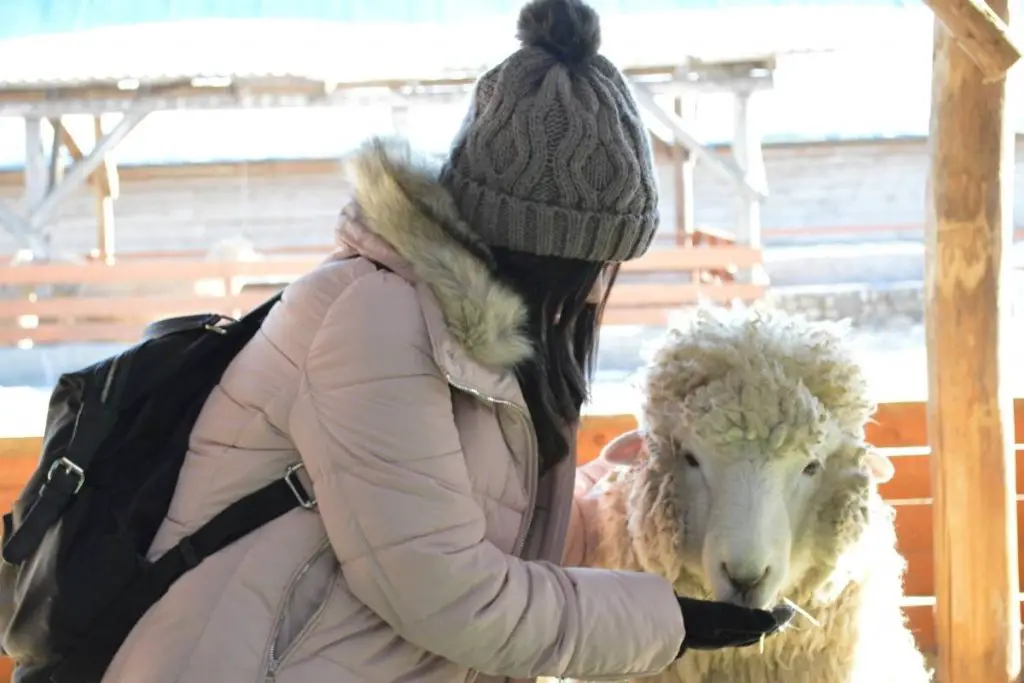
Here’s how you can care for sheep in winter:
- Provide shelter. Sheep usually stay outside, even during winter. However, they need protection when the weather gets too harsh. A barn, a three-sided shed, or even just a tree line works excellently on a sheep farm, depending on how cold it gets in your location. If you build an enclosed shed, remember to provide enough ventilation and fresh and clean bedding for the sheep to lie on.
- Keep them well fed. Sheep normally eat more during winter to produce more heat and compensate for lost energy. Ohio State University advises giving your sheep extra food when the temperature goes below 25°F. For every 10 degrees below 25°F, add ¼ lb. of feed per sheep.
- Provide warm drinking water. It’s hard for livestock to drink icy water, let alone frozen water. You can warm your sheep’s drinking water using submersible heaters in their water troughs. Check on the water at least twice daily to remove any ice formation in the drinking water.
- Keep the sheep dry. When it’s raining or snowing during wintertime, ensure your sheep get out of the rain and stay in the barn to keep dry. This will help to keep them warm.
- Remove ice from pasture, drinking water, and sheep’s bodies. It’s winter, so it’s expected that almost everything outside will soon have ice on it. This can mean difficulty accessing pasture and drinking water. If you want your sheep grazing outside in winter, you must remove the ice regularly from the pasture. You must also remove ice from their drinking water and bodies.
- Increase hoof care. Hoof care should be a regular practice year-round, but especially in winter. Avoid overgrowth of your sheep’s hoofs by trimming them at least after every two months or so. Treat any damage to the hooves caused by ice or other sharp objects on the ground.
- Manage the shearing process to allow longer coats in winter. Proper timing of the shearing season is essential to ensure your sheep have grown long coats by winter. Most farmers shear their sheep during springtime.
- Plan and care for lambing ewes. Lambing ewes need extra care, especially during winter. Firstly, do the shearing about a month before lambing. Secondly, as winter approaches, prepare a shelter for the ewes and keep them indoors when they are about to lamb. The aim is to ensure the lambs aren’t born in the cold outside.
- Keep newborn lambs warm and dry. After lambs are born, dry off the amniotic fluid from their body immediately and allow them to nurse. This prevents cold stress and hypothermia. Young lambs and their mothers should be kept in the barn for 2-3 weeks. This allows young lambs to nurse and grow in the warmth before being exposed to extreme cold outside.
Creating a winter shelter for your sheep
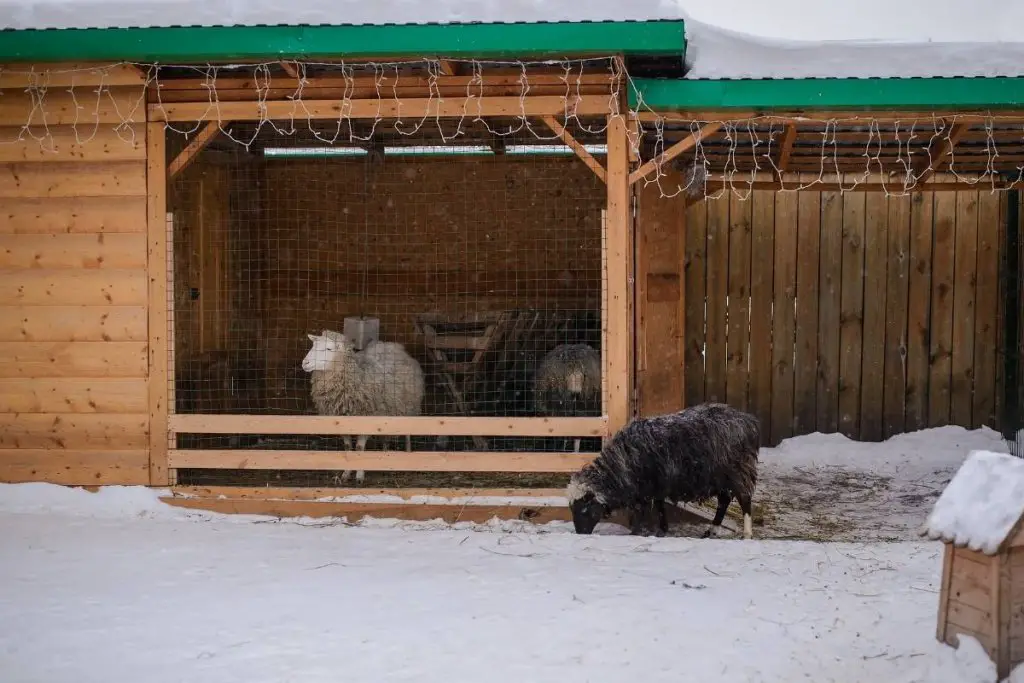
Sheep don’t need to be inside all day, even in winter. They are generally comfortable roaming the snow-covered fields in search of pasture.
However, helps if you still prepared a shelter for your flock of sheep. They can stay in the shed at night or gather during the day when it’s freezing, during a snowstorm, or when it’s very windy.
Depending on how harsh the winter gets, you can build an enclosed structure, e.g., a barn or a simple three-sided shed.
Using a barn for shelter
A barn is a large enclosed building on a farm where livestock can stay, especially during inclement weather. It’s complete with a door and windows to keep the cold out.
Insulating the barn during winter is essential to increase the warmth inside. If the windows are open-air, consider covering them with plexiglass or standard glass windows. However, if the winter is not too cold, you can cover the windows with curtains made of plastic sheeting.
Having enough bedding in the barn also helps with insulation. Remember to clean the barn regularly and spread fresh bedding to keep the sheep comfortable.
For bedding, you can use:
- Hay
- Straw
- Wood chips
- Corn stalks
- Pine shavings
- Peanut hulls
Remember to allow enough ventilation in the barn. Build up of ammonia from the animal’s urine and moisture can cause respiratory problems like bronchitis and pneumonia in your animals.
Don’t keep your sheep locked in the whole day. Let them go outside to get fresh air and exercise.
During very cold winters, you can use heat lamps in the barn (but do so with extreme caution). Keep the heat lamps out of reach of the animals and only use them when it’s absolutely necessary. Some experts advise against using heat lamps because of the risk of electrocutions and barn fires.
Using a three-sided shed for shelter
For mild winters, a three-sided shed may be all you need. The shed will act as a windbreak and allow your sheep to keep dry when it’s raining or during snowfall.
The good thing about this simplicity of this shed is that the sheep can get in and out without restrictions.
Risks to your sheep in winter
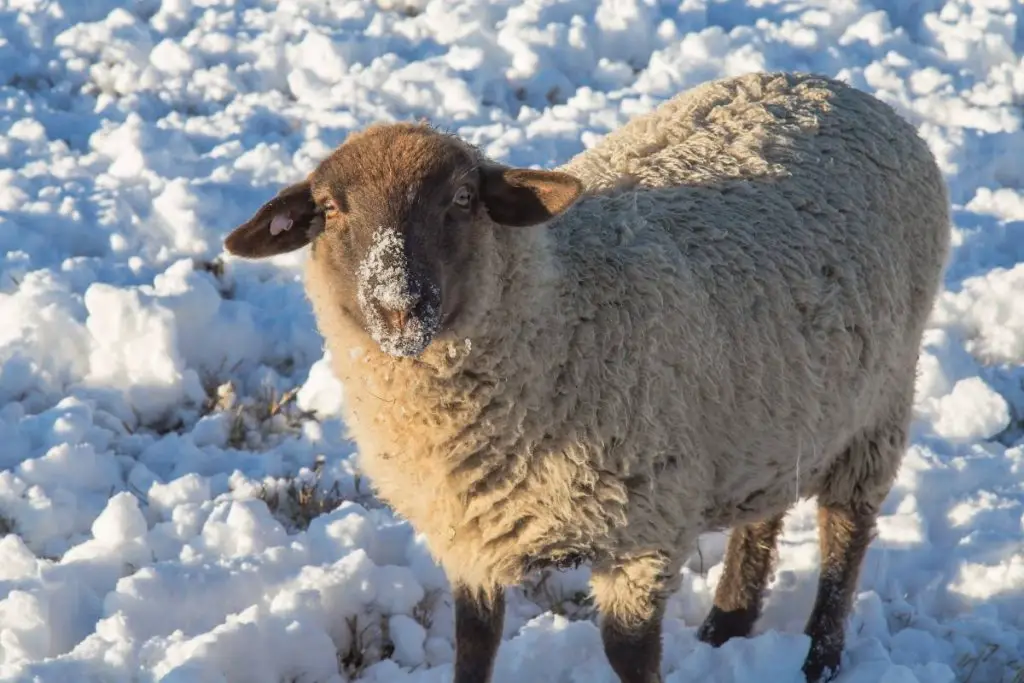
During winter, sheep can experience cold-weather-related injuries and illnesses. Here are the most common:
- Cold stress. This occurs when the temperatures are so low that the sheep require extra energy to maintain their core body temperature. When animals experience cold stress and cannot generate more heat, they end up with hypothermia.
- Hypothermia. This is an extreme drop in body temperature. It often occurs when the animal doesn’t have enough energy reserves to generate heat from within. Lambs and sick sheep are most likely to experience hypothermia. However, even healthy sheep can become hypothermic if not well cared for.
- Frostbite. This is damage that occurs to body tissue as a result of freezing. The most affected tissues are on the extremities, e.g., the tail, ears, feet, teats, and scrotum. Frostbite is more likely to occur when the animal is wet and exposed to windy conditions during cold winters.
So how do you protect your sheep from these cold-related conditions?
Keep your sheep warm, dry, well-fed, and hydrated during the cold seasons.
Breeds of sheep that do best in the snow
The following sheep tend to do well in the snow:
- Leicester Longwool – Leicester Longwool is a longwool breed designed for wool production. It grows a nice warm winter coat that can withstand extreme conditions.
- Icelandic – The Icelandic sheep is native to Iceland’s cool, wet climate. It’s also a long wool sheep that grows a warm winter coat.
- Black Welsh Mountain – Black Welsh Mountain sheep reproduce only once a year. That makes it easy to avoid lambing during the winter.
- Shetland – Shetland sheep are hardy. These sheep were raised in Shetland Island’s cold and wet climate.
- Romney – Romney sheep get their excellent cold tolerance from their original habitat of England.

